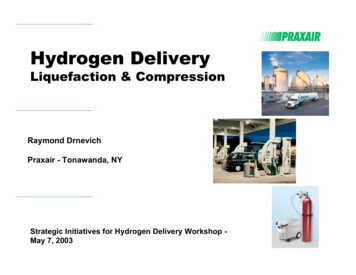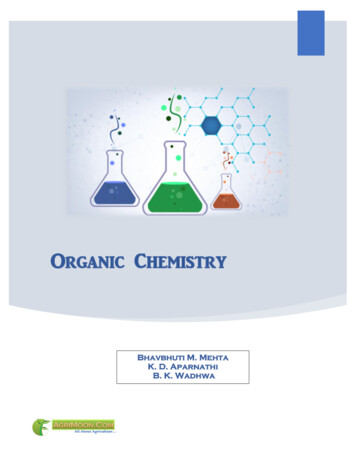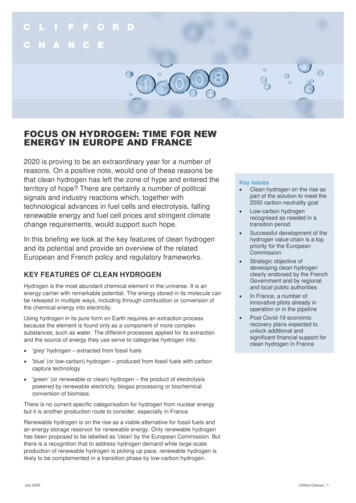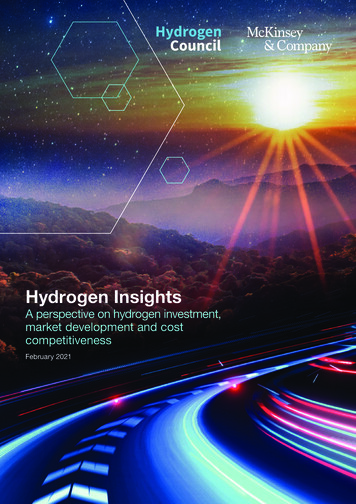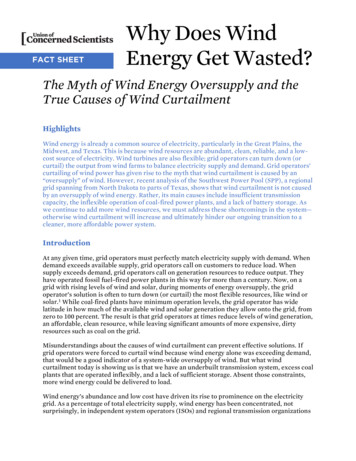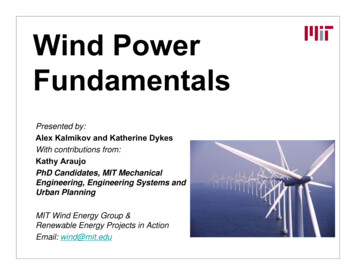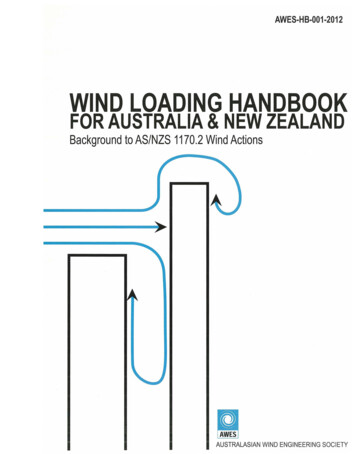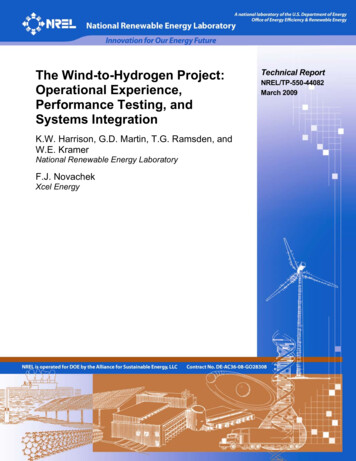
Transcription
The Wind-to-Hydrogen Project:Operational Experience,Performance Testing, andSystems IntegrationK.W. Harrison, G.D. Martin, T.G. Ramsden, andW.E. KramerNational Renewable Energy LaboratoryF.J. NovachekXcel EnergyTechnical ReportNREL/TP-550-44082March 2009
The Wind-to-Hydrogen Project:Operational Experience,Performance Testing, andSystems IntegrationK.W. Harrison, G.D. Martin, T.G. Ramsden, andW.E. KramerNational Renewable Energy LaboratoryF.J. NovachekXcel EnergyPrepared under Task No. H271.3730National Renewable Energy Laboratory1617 Cole Boulevard, Golden, Colorado 80401-3393303-275-3000 www.nrel.govNREL is a national laboratory of the U.S. Department of EnergyOffice of Energy Efficiency and Renewable EnergyOperated by the Alliance for Sustainable Energy, LLCContract No. DE-AC36-08-GO28308Technical ReportNREL/TP-550-44082March 2009
NOTICEThis report was prepared as an account of work sponsored by an agency of the United States government.Neither the United States government nor any agency thereof, nor any of their employees, makes anywarranty, express or implied, or assumes any legal liability or responsibility for the accuracy, completeness, orusefulness of any information, apparatus, product, or process disclosed, or represents that its use would notinfringe privately owned rights. Reference herein to any specific commercial product, process, or service bytrade name, trademark, manufacturer, or otherwise does not necessarily constitute or imply its endorsement,recommendation, or favoring by the United States government or any agency thereof. The views andopinions of authors expressed herein do not necessarily state or reflect those of the United Statesgovernment or any agency thereof.Available electronically at http://www.osti.gov/bridgeAvailable for a processing fee to U.S. Department of Energyand its contractors, in paper, from:U.S. Department of EnergyOffice of Scientific and Technical InformationP.O. Box 62Oak Ridge, TN 37831-0062phone: 865.576.8401fax: 865.576.5728email: mailto:reports@adonis.osti.govAvailable for sale to the public, in paper, from:U.S. Department of CommerceNational Technical Information Service5285 Port Royal RoadSpringfield, VA 22161phone: 800.553.6847fax: 703.605.6900email: orders@ntis.fedworld.govonline ordering: http://www.ntis.gov/ordering.htmPrinted on paper containing at least 50% wastepaper, including 20% postconsumer waste
AcknowledgmentsThe authors would like to recognize Rick Farmer, Roxanne Garland, and Jamie Holladayof the U.S. Department of Energy for funding this work. George Sverdrup of the NationalRenewable Energy Laboratory (NREL) and Vicki McCarl of Xcel Energy were both veryhelpful in scoping and defining the Wind2H2 project and have provided excellentfeedback throughout the project. Brad Hollenbaugh and Curtis Perry of Xcel Energy wereinstrumental in helping design and configure the Wind2H2 system and in participating inthe readiness verification review. The authors would like to acknowledge John Cornish ofEPC and Marc Mann of Spectrum Automation for their work installing and programmingthe Wind2H2 system. The authors would like to thank Connie Komomua for herassistance in editing the work. Finally, the authors would like to thank Robert Remick,Dave Mooney, Ben Kroposki, Mike Stewart, and Genevieve Saur of NREL for theirtechnical assistance throughout the project.iii
List of FPGAGUIH2HHVhrI-VICEIGBTIRISCkgkHzKOHLFLLHVm/smA PLCalternating currentAC-to-DCAmerican Society of Mechanical Engineersatmospherecombustible gasdirect currentDC-to-DCDistributed Energy Resources Test Facilityde-ionizedU.S. Department of EnergyEngineering Procurement & ConstructionEmergency Stopfield programmable gate arraygraphical user interfacehydrogenhigher heating valuehourcurrent versus voltageinternal combustion engineinsolated gate bipolar transistorohmic lossesshort circuit currentkilogramskiloHertzpotassium hydroxidelower flammability limitlower heating valuemeters per secondmilliamps per centimeter squaredmilliHenryMeasurement and Instrumentation Data Centermiles per hourmaximum power pointmaximum power point trackingmegawattsmega ohm-centimeterNational Electric Codenormal cubic meters per hourNational Renewable Energy LaboratoryNational Wind Technology Centerpower electronicspolymer electrolyte membraneprogrammable logic controlleriv
ckμJparts per million by volumepounds per square inch gaugeplatinumphotovoltaicrenewable energyroot-mean-squaredresistive temperature devicereadiness verificationstandard cubic feet per hoursoft-load transfer switchstandard test conditionsultraviolet/infraredvoltage versus currentopen circuit voltagewyestack efficiencymicrojoulesv
Executive SummaryXcel Energy and the U.S. Department of Energy’s (DOE) National Renewable EnergyLaboratory (NREL) have collaborated to design, install, and operate the Wind-toHydrogen (Wind2H2) project. As the largest provider of wind generated electricity in theUnited States, Xcel Energy is working proactively with NREL to establish andunderstand state-of-the-art renewable electrolysis equipment and the operation of arenewable hydrogen production facility. Hosted at NREL’s National Wind TechnologyCenter (NWTC), the Wind2H2 system was approved for initial operation in March 2007and is enjoying success as a demonstration project, producing hydrogen directly fromrenewable energy sources. This unique research-oriented project uses solar and windenergy to produce and store hydrogen. The stored hydrogen can be used both as atransportation fuel and as an energy storage medium, effectively allowing renewableenergy to be stored and converted back to electricity at a later time.The Wind2H2 project is helping researchers understand the hurdles and potential areasfor improvement in emerging renewable electrolysis technologies. By allowing engineersto operate and configure an integrated electrolysis facility, this project has enabled theinvestigation and analysis of hydrogen production, compression, storage, and electricitygeneration that is providing valuable data that are being used to improve the designs offuture renewable electrolysis systems. This first report on the Wind2H2 project providesimportant guidance to industry and key stakeholders for development of future renewableelectrolysis systems.The Wind2H2 project is the only renewable hydrogen production facility in the worldthat can operate multiple electrolyzers in any of the following configurations:1. Grid connected2. Directly connected from the output of a photovoltaic array to the electrolyzerstack3. Real-time electrolyzer stack current control based on a power signal from a windturbine4. Closely coupled photovoltaic (PV) and wind energy sources to the electrolyzerstack with custom designed and built power electronics.NREL and Xcel Energy have undertaken the Wind2H2 project with several keyobjectives in mind. First and foremost, the Wind2H2 project is being used to demonstrateoperation of a renewable electrolysis system, allowing researchers to evaluate actualsystem performance and costs and to identify areas for cost and efficiency improvements.Additionally, the project provides operational experience with a renewable electrolysishydrogen production facility, enabling project engineers to investigate operationalchallenges and to explore system-level integration issues and opportunities forperformance and cost improvements resulting from system-level optimization. Theproject also seeks to investigate how to maximize the use of renewable energy resourcesin renewable hydrogen production systems by optimizing energy transfer from PV arraysand wind turbines to the stacks of commercial electrolyzers. Finally, the project isdesigned to explore operational challenges and opportunities related to energy storagevi
systems and their potential for addressing electric system integration issues inherent withhigh penetrations of variable renewable energy resources.To help enable greater penetration of renewable energy sources, hydrogen productionfrom renewable electrolysis must be cost-competitive. DOE has a target of reducing thecost of central production of hydrogen from wind-based water electrolysis to 3.10/kg by2012; by 2017 DOE seeks to reduce this cost to under 2/kg. 1 Electrolyzermanufacturers are improving performance and reducing the capital cost of electrolyzersystems. At the same time, the complete renewable electrolysis system, including therenewable power source, electrolyzer, and interfacing power electronics, must beintegrated and optimized to improve system performance and lower costs. The Wind2H2project presents an excellent research platform to investigate these integration andoptimization opportunities.To achieve the objectives of the Wind2H2 project, NREL engineers have been workingto complete a number of project tasks. These tasks include: Designing, building, and testing dedicated wind- and PV-to-electrolyzer stackpower electronics to more closely integrate the renewable energy resources andelectrolyzer stacks Modeling and simulating renewable electrolysis system performance to enableimproved hydrogen production system designs Characterizing renewable energy system impacts on commercial electrolyzertechnology and their ability to accommodate the varying energy input from windand PV sources Sequencing multiple electrolyzer systems to improve overall system efficiency,responsiveness, and performance with varying renewable energy sources.The challenge of renewable electrolysis is designing and implementing systems that cancost-effectively produce hydrogen from renewable sources using streamlined, robust, andefficient processes. When the wind turbine or solar array is co-located with theelectrolysis system, more direct connection between the source and the electrolyzer stackis possible. This close-coupling eliminates the need for long distance transportation ofelectricity and reduces the number of electrical conversions resulting in a more efficient,cost-effective system.In this report, specifications of the Wind2H2 equipment (electrolyzers, compressor,hydrogen storage tanks, and the hydrogen fueled generator) are summarized. Systemoperational experience and lessons learned are discussed. Valuable operationalexperience is shared through running, testing, daily operations, and troubleshooting theWind2H2 system and equipment errors are being logged to help evaluate the reliability of1U.S. Department of Energy, (October 2007). Hydrogen, Fuel Cells & Infrastructure TechnologiesProgram: Multi-Year Research, Development and Demonstration Plan. Office of Energy Efficiency andRenewable Energy.vii
the system. Project engineers have learned a number of valuable lessons from this systemoperational experience that will lead to improved design, implementation, and operationalplans of renewable electrolysis systems. For example, integrated renewable electrolysissystems require that system components from different manufacturers be configured tofunction smoothly together. In light of this, programmable logic control systems need tobe able to communicate with all major elements of the system (e.g., electrolyzers,compressors, power converters, and load transfer switches).As another primary goal of the project, NREL engineers have investigated how tomaximize renewable energy use and optimize energy transfer within the system. Thesetypes of system optimization efforts can significantly reduce the cost of renewablehydrogen. In an analysis of the potential improvements to a wind electrolysis system,project engineers estimated that optimized power electronics would result in a costimprovement of seven percent, reducing the cost of hydrogen produced from wind to 5.83/kg from a baseline of 6.25/kg 2. For reference, DOE has a target for reducing thecost of central production of hydrogen from wind-based electrolysis to 3.10/kg by 2012.To investigate such optimization opportunities, NREL developed multiple powerelectronics configurations that convert varying electricity from a solar PV array and windturbines into the electricity used by the electrolyzer stacks directly. These powerconverters have the added benefit of executing maximum power point tracking (MPPT)from the wind turbine or PV array to enable higher energy transfer to the electrolyzerstack than a simple, unoptimized, direct connect configuration.Two electrolyzer technologies are being tested and characterized—namely, polymerelectrolyte membrane (PEM) and alkaline electrolyzer systems. Efficiencies of the PEMand alkaline electrolyzers were calculated using experimental data from systemoperation. Electrolyzer system and stack efficiency is reported on both the higher heatingvalue (HHV) basis of hydrogen (39.4 kWh/kg) and the lower heating value (LHV) basis(33.3 kWh/kg). Table 1 summarizes the results of electrolyzer stack and electrolyzersystem efficiency measurements. Stack efficiency peaks at low current while the overallelectrolyzer system efficiency is greatest when operating at rated stack current.Table 1: Electrolyzer system and stack efficiencyEfficiencyPEM ElectrolyzerAlkaline ElectrolyzerLHVHHVLHVHHVLow Current80% (5A)95% (5A)78% (30A)92% (30A)Rated Current63% (5A)75% (135A)59% (220A)70% (220A)Low Current0% (15A)0% (15A)0% (35A)0% (35A)Rated Current49% (135A)57% (135A)35% (220A)41% (220A)Stack EfficiencySystem Efficiency2See Section 5.2 for the full description and assumptions of this analysis.viii
Voltage-current (V-I) characteristic curves were obtained by sweeping direct current(DC) to the electrolyzer stack. These V-I curves are compared with the theoretical stackvoltage (1.48 V per cell) adjusted for the nominal electrolyzer operating gas pressure todetermine stack efficiency. System efficiency is determined by summing the electrolyzerstack load plus all ancillary electrical loads divided by the amount of hydrogen producedin kilograms (kg) compared with the HHV of hydrogen.The PV array connected to the electrolyzer stack with and without an intermediary powerconverter was tested and analyzed. The PV array was configured to supply different inputvoltages to a step-down, DC-to-DC (DC/DC) power converter over many days of testing.We found that the use of the power converter increases the energy delivered to theelectrolyzer stack by 10% – 20%, depending on the PV array input voltage to the powerconverter. The efficiency of the power converter decreased as the input voltage from thePV array increased. Still, the highest input voltage from the PV array to the powerconverter provided the maximum energy capture to the electrolyzer stack. In other words,while suffering from the largest difference between PV voltage and electrolyzer stackvoltage (ΔV), the configuration provided the largest amount of energy to the stack over agiven day.A 10 kW wind turbine was connected to one of the PEM electrolyzer stacks through anMPPT-alternating current (AC)-to-DC power converter. This configuration represents anon-grid-tied (i.e., stand-alone) configuration closely coupling a wind turbine to theelectrolyzer stack. Testing and analysis shows that the AC-to-DC (AC/DC) converter hasthe ability to both maintain optimal operation of the turbine while delivering power to theelectrolyzer stack without a battery link. It eliminates several power electronicsconversions inherent in grid-tied electrolyzer configurations as well as a battery andassociated maintenance. This AC/DC power converter is undergoing upgrades that areexpected to further increase the energy capture from the wind turbine.Operation of the Wind2H2 system will continue with a focus on achieving projectobjectives. Future work includes the continued design and testing of optimizationstrategies and hardware, along with performance evaluation of these improved systems.This includes maximizing the transfer of wind and solar energy by better integratingsystem components and developing optimized power electronics packages. Improvedsequencing of electrolyzer stacks to maximize hydrogen output will be designed,implemented, and tested and these optimized system configurations will be analyzed todetermine the performance of the revised systems. Finally, a virtual connection betweenthe 100 kW wind turbine power signal and 30 kW alkaline stack power controller willvary stack current and enable the characterization of the system performance underhighly varying conditions.One of the major tasks going forward will be to determine how the findings of theWind2H2 project can improve performance and reduce the cost of renewable electrolysisproduction systems. The results of system optimization efforts, performancemeasurements, and evaluation data will be used in economic models to better understandhow these system improvements can lower the cost of hydrogen produced via renewableelectrolysis.ix
KEY FINDINGS AND LESSONS LEARNED TO DATE System Integration: More research and engineering design related to renewableelectrolysis system integration will improve energy transfer and overall system efficiencyand reduce system complexity and capital costs.oDevelopment of optimized power electronics packages in particular is apromising area for system-level improvements.oDevelopment of open architecture communication protocols between differentcomponent manufacturers would greatly simplify system integration efforts. Codes and Standards: Development of clear and consistent codes and standards willexpedite implementation and reduce the cost of renewable electrolysis projects Efficiency Measurements: Based on the testing of the Wind2H2 project’s smallelectrolyzer systems, PEM electrolyzers were found to be more efficient than the alkalineelectrolyzer; counter to expectations. Energy Transfer Optimization:oAnalysis shows a potential 7% reduction in the cost of hydrogen if the windturbine inverters are replaced with DC/DC converters that feed directly to theelectrolyzer stacks.oFor solar PV systems, NREL determined that the use of an optimized powerelectronics package (called a maximum power point tracking system – MPPT)captured between 10% and 20% more energy than a direct connection to theelectrolyzer stack.IMPLICATIONS FOR ELECTRIC UTILITIES’ COMPONENT SUPPLIERS ANDHYDROGEN-BASED ENERGY STORAGE SYSTEMS INTEGRATORSNotwithstanding the previously identified issue that hydrogen-based energy storage systemcomponent capital costs and efficiencies must continue to improve to become competitivewith other electric utility production and storage options, the following needs must also beaddressed:o Establish open architecture and communication protocolso Design wind turbines and electrolyzers with each other in mind, to be part of anenergy storage systemo Simplify and standardize codes and standards for electrolysis-based energystorage systemso Optimize energy transfer within the system and eliminate redundant componentso Standardize system sizes and match component sizes. Until standardized designsand component sizes are developed, system integrators need to determineappropriate component sizes to meet the needs of electrolysis-based energystorage projects on a case-by-case basis.x
Table of ContentsList of Acronyms . iiiiExecutive Summary . vi1234Introduction . 11.11.21.31.41.5Project Overview . 1Project Objectives . 2Hydrogen Production and Renewable Electrolysis. 4NREL and Xcel Energy Partnership . 6Project Status and Plan. 6System Overview . 82.1Hydrogen System . 132.1.1 PEM Electrolyzers (E-120 and E-130) . 132.1.2 Alkaline Electrolyzer (E-110) . 152.1.3 Compressor (C-200). 162.1.4 Hydrogen Storage Tanks. 162.1.5 Internal Combustion Generator (G-400) . 172.2Safety Systems and Controls . 172.2.1 Production and Compression Building . 172.2.2 Emergency Stops . 182.2.3 Hydrogen Detection . 182.2.4 Ventilation. 192.2.5 Fire Detection and Alarm. 192.2.6 Hydrogen Vent Flare Monitor . 192.2.7 High Pressure Isolation . 192.3Renewable Energy Sources. 192.3.1 Photovoltaic Solar Array. 192.3.2 Bergey 10 kW Wind Turbine. 212.3.3 NorthWind 100 Wind Turbine . 232.4Power Electronics . 242.4.1 DC-to-DC Buck Converter with MPPT . 242.4.2 AC-to-DC Turbine MPPT Converter. 252.5Data Acquisition and Monitoring . 27System Installation and Operation . 283.13.23.33.43.5Introduction . 28System Installation and Configuration. 29Safety, Hazardous Operations Review, and Readiness Verification . 30System Operational Experience . 32Operational Lessons Learned . 32Baseline Testing and Analysis. 334.1Introduction . 334.2PEM Electrolyzer Performance . 344.2.1 E-130 Stack Polarization Curves . 34xi
5674.2.2 E-130 Stack Voltage Efficiency. 354.2.3 E-130 System Efficiency (HHV) . 364.3Alkaline Electrolyzer Performance . 374.3.1 E-110 Stack Polarization Curves . 374.3.2 E-110 Stack Voltage Efficiency. 384.3.3 E-110 System Efficiency (HHV) . 39System Integration and Optimization . 405.1Introduction . 405.2Economic Analysis of System Integration Opportunities . 415.3Small Wind Powered Electrolysis Testing and Analysis . 435.3.1 Objective . 435.3.2 Approach . 445.3.3 Simulation . 445.3.4 Hardware . 445.3.5 Control Strategy . 455.3.6 Test Results . 465.4Solar-Powered Electrolysis Testing and Analysis . 505.4.1 Objective . 505.4.2 Overview and Results . 505.4.3 Full Array Power Direct Connect (Tests 1–3) . 555.4.4 Full Array-Power MPPT Electronics (Tests 4–11). 585.4.5 Split Array Direct and MPPT Comparison (Tests 12–15) . 625.5Large Wind powered Electrolysis. 645.5.1 Investigation of Close-Coupling Options . 645.5.2 Real-Time Electrolyzer Operation Linked to Wind Turbine Output . 675.6Summary of Results and Key Findings . 67Future Work . 686.16.26.36.46.5Renewable Electrolysis Cost Analysis and Modeling . 68PV-Powered Electrolysis (Phase 2) . 6910 kW Wind-Powered Electrolysis . 70100 kW Wind-Powered Electrolysis . 71Electrolyzer Sequencing and Autonomous Operation . 72Conclusion . 72Appendices . 74xii
List of FiguresFigure 1-1: Overall Wind2H2 system diagram. 2Figure 1-2: Wind2H2 project timeline. 7Figure 2-1: Aerial photograph of Wind2H2 site and equipment . 8Figure 2-2: Baseline grid connected (AC) system configuration . 9Figure 2-3: PV-powered electrolysis system configuration with DC/DC power converterto PEM electrolyzer stack . 10Figure 2-4: 10 kW wind powered electrolysis system configuration with AC/DC powerconverter to PEM electrolyzer stack . 10Figure 2-5: 100 kW wind powered electrolysis system configuration using real-timepower signal to vary stack current . 11Figure 2-6: 100 kW wind powered electrolysis system with PE interface to stack. 11Figure 2-7: PEM electrolyzer enclosure and internal components . 14Figure 2-8: Alkaline hydrogen generator system components . 15Figure 2-9: Hydrogen compressor . 16Figure 2-10: Hydrogen storage tanks. 17Figure 2-11: Hydrogen-fueled internal-combustion generator . 17Figure 2-12: 5 kW east PV array at NREL’s DERTF . 20Figure 2-13: SX-120s solar panel I-V characteristic . 20Figure 2-14: 10 kW Bergey Excel-S wind turbine at the NWTC . 21Figure 2-15: Enhanced wind-to-hydrogen system. . 22Figure 2-16: Bergey Excel-S experimental power data . 22Figure 2-17: 100 kW NorthWind 100 turbine located at NREL's NWTC . 23Figure 2-18: Manufacturer-provided power curve for NorthWind 100 turbine at standard(sea level) air density. .
Xcel Energy and the U.S. Department of Energy's (DOE) National Renewable Energy Laboratory (NREL) have collaborated to design, install, and operate the Wind-to-Hydrogen (Wind2H2) project. As the largest provider of wind generated electricity in the United States, Xcel Energy is working proactively with NREL to establish and


